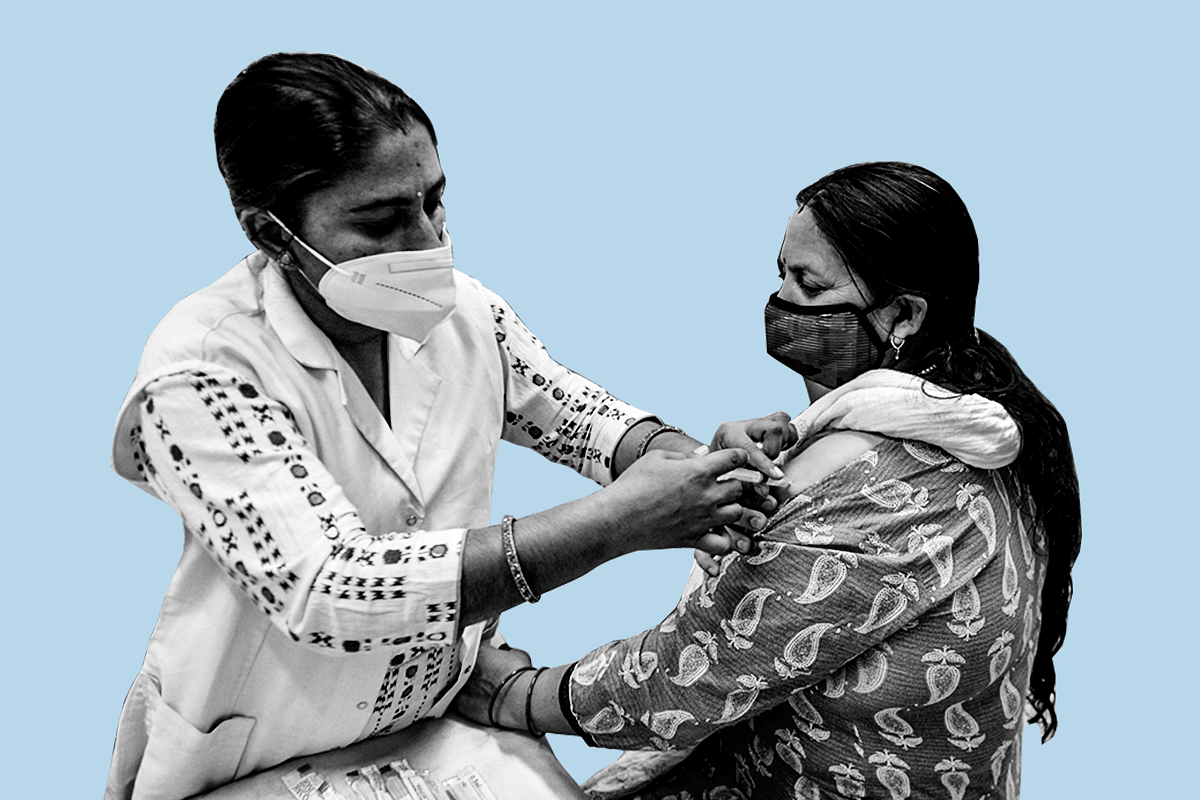News Brief
Data Shows COVID-19 Jab Effectively Protected Those Above 60 In Second Wave; By When Can India Expect Full Vaccination?

Covid-19 Vaccination Drive
A team of scientists has reported that data shows that the vaccination programme has been effective in reducing infections among those aged 60 and above.
An article authored by T S Ganesan, Professor, Medical Oncology and Clinical Research, Cancer Institute (WIA), Chennai; R Rajaraman, Professor, Homi Bhabha National Institute, Indira Gandhi Centre for Atomic Research, Kalpakkam; and R Shankar, Honorary Professor, The Institute of Mathematical Sciences, Chennai; and published in The Hindu charts the growth in COVID-19 infection with vaccination.
The vaccination for COVID-19 has been available in India from mid January this year. In the first round, the priority groups identified by the government — front-line staff including doctors, nurses, technicians and hospital staff; people over 60 years of age, and then over 45 years of age — became eligible for vaccination.
In the second round, all those above 18 years became eligible for vaccination from 1 May.
The article states that the analysis of the available data from November 2020 and the second wave in Tamil Nadu suggest that the vaccination of people over 60 years of age has already started showing a positive effect.
“The proportion of new COVID-19 positive patients in this age group has fallen since vaccination started. In comparison, the number of positive cases among those in the age group below 60 years shows an increase.”
In the accompanying graphs, one can clearly see that in Tamil Nadu, the percentage of daily confirmed cases kept increasing sharply after March 2021 for the below-60 age group while for the above-60 age group (vaccination started from 1 March), the graph shows a decline.
Similarly for the state capital Chennai, the number of active cases (as percentage of population) kept increasing for the below-50 age group while for the above-60 age group (vaccination started from 1 March), the graph shows a decline. For the 50-59 age group, the graph shows a modest decline.
While the absolute numbers show an increase in cases across all age groups, the percentage of infected people over 60 years of age shows a definite decrease.
The researchers note:
“At present, in Tamil Nadu, only 16 per cent of those above 60 years and 4 per cent of those below 60 years (projected population in 2021) have been vaccinated (one dose). However, there is a 7 per cent decrease in infections among those above 60 years of age.”
“These results strongly suggest the positive impact of vaccination. Similar reduction can be expected in the number of deaths among those above 60 years of age. However, analysis of death data is not meaningful at this stage owing to large scatter in reported deaths.”
How will India vaccinate its population?
The union government informed the Supreme Court day before that vaccine production is being gradually ramped up across the country.
The Serum Institute of India (SII) has ramped up production from five crore doses a month to 6.5 crore doses. Similarly, Bharat Biotech Intl Ltd. had hiked production from 90 lakh a month to two crore.
By July 2021, the Russian Sputnik-V is expected to increase production from 30 lakh to 1.2 crore doses a month; Bharat Biotech is expected increase up to 5.5 crore doses per month and SII was also expected to further increase the production.
G Padmanaban, former Director, IISc, and Senior Science Innovation Adviser, Department of Biotechnology, Government of India says that India needs about 150 crore doses (two doses per person) to vaccinate the target population.
Apart from the Covishield from SII, Covaxin from Bharat Biotech, and the Russian Sputnik-V (already approved), India has fast-tracked the approval to other coronavirus vaccines that have been given emergency use authorisation in US, UK, EU, Japan, or by the World Health Organization.
These will not be required to conduct a “bridging trial” prior to seeking approval. Instead, the government will allow them to roll out these coronavirus vaccines and conduct “parallel bridging clinical trial”. The first 100 beneficiaries of such foreign vaccines shall be assessed for seven days for safety outcomes before it is rolled out for further immunisation programme within the country. These include Pfizer, Moderna and Johnson & Johnson (J&J) products.
Apart from these, Padmanaban lists the DNA vaccine (for spike protein) by Zydus Cadila, the recombinant spike protein (Biological E), and self-amplifying messenger RNA (Sa-mRNA for spike protein) by Gennova as promising candidates that can reach field application in four months.
India has covered about 10 per cent of the target population. According to Padmanaban, with five approved vaccines, some outside help and an aggressive vaccination timeline, India should be able to vaccinate the target population in six months from now.
Support Swarajya's 50 Ground Reports Project & Sponsor A Story
Every general election Swarajya does a 50 ground reports project.
Aimed only at serious readers and those who appreciate the nuances of political undercurrents, the project provides a sense of India's electoral landscape. As you know, these reports are produced after considerable investment of travel, time and effort on the ground.
This time too we've kicked off the project in style and have covered over 30 constituencies already. If you're someone who appreciates such work and have enjoyed our coverage please consider sponsoring a ground report for just Rs 2999 to Rs 19,999 - it goes a long way in helping us produce more quality reportage.
You can also back this project by becoming a subscriber for as little as Rs 999 - so do click on this links and choose a plan that suits you and back us.
Click below to contribute.
Latest